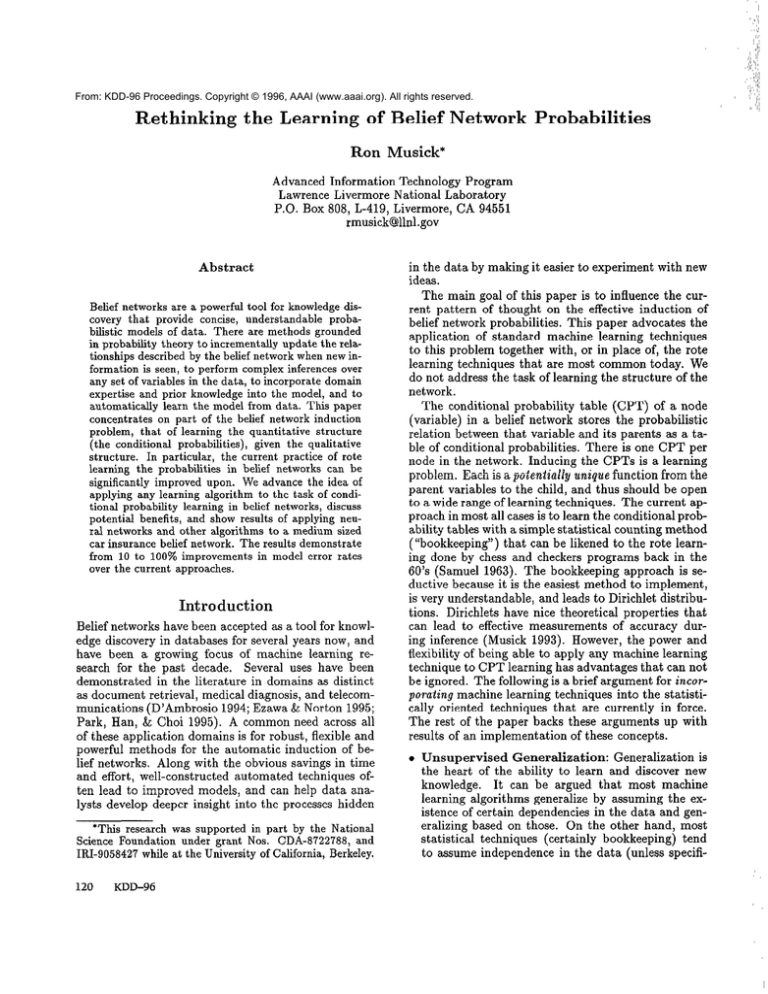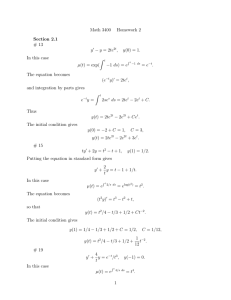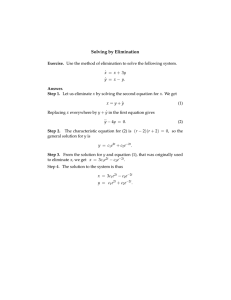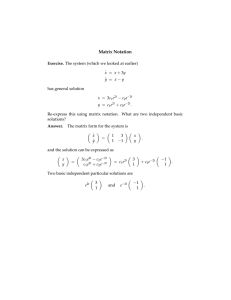
From: KDD-96 Proceedings. Copyright © 1996, AAAI (www.aaai.org). All rights reserved.
Rethinking
the Learning
of Belief
Network
Probabilities
Ron Musick*
Advanced Information Technology Program
Lawrence Livermore National Laboratory
P.O. Box 808, L-419, Livermore, CA 94551
rmusick@llnl.gov
Abstract
Belief networks are a powerful tool for knowledge discovery that provide concise, understandable probabilistic models of data. There are methods grounded
in probability theory to incrementally update the relationships described by the belief network when new information is seen, to perform complex inferences over
any set of variables in the data, to incorporate domain
expertise and prior knowledge into the model, and to
automatically learn the model from data. This paper
concentrates on part of the belief network induction
problem, that of learning the quantitative structure
(the conditional
probabilities),
given the qualitative
structure. In particular, the current practice of rote
learning the probabilities
in belief networks can be
significantly improved upon. We advance the idea of
applying any learning algorithm to the task of conditional probability learning in belief networks, discuss
potential benefits, and show results of applying neural networks and other algorithms to a medium sized
car insurance belief network. The results demonstrate
from 10 to 100% improvements in model error rates
over the current approaches.
Introduction
Belief networks have been accepted as a tool for knowledge discovery in databases for several years now, and
have been a growing focus of machine learning research for the past decade. Several uses have been
demonstrated in the literature in domains as distinct
as document retrieval, medical diagnosis, and telecommunications (D’Ambrosio 1994; Ezawa & Norton 1995;
Park, Han, & Choi 1995). A common need across all
of these application domains is for robust, flexible and
powerful methods for the automatic induction of belief networks. Along with the obvious savings in time
and effort, well-constructed automated techniques often
~mncnyrl bU III"UtAU)
mnrlaln
"1&l lo~rl
1usA.u tr,
"V A'lly'"
nnrl b-11
cnn help
CbIIU
&,$,,ta a.;;a-
lysts develop deeper insight into the processes hidden
*This research was supported in part by the National
Science Foundation under grant Nos. CDA-8722788, and
IRI-9058427 while at the University of California, Berkeley.
120
KDD-96
in the data by making it easier to experiment with new
ideas.
The main goal of this paper is to influence the current pattern of thought on the effective induction of
belief network probabilities. This paper advocates the
application of standard machine learning techniques
to this problem together with, or in place of, the rote
learning techniques that are most common today. We
do not address the task of learning the structure of the
network.
The conditional probability table (CPT) of a node
(variable) in a belief network stores the probabilistic
relation between that variable and its parents as a table of conditional probabilities. There is one CPT per
node in the network. Inducing the CPTs is a learning
,--AI -I,..
2-...l.--L..LY~~~~Al-problem. Each is a ~iocensraccy ‘unzque Iunc6ion Irom 6ne
parent variables to the child, and thus should be open
to a wide range of learning techniques. The current approach in most all cases is to learn the conditional probability tables with a simple statistical counting method
(“bookkeeping”) that can be likened to the rote learning done by chess and checkers programs back in the
60’s (Samuel 1963). The bookkeeping approach is seductive because it is the easiest method to implement,
is very understandable, and leads to Dirichlet distributions. Dirichlets have nice theoretical properties that
can lead to effective measurements of accuracy during inference (Musick 1993). However, the power and
flexibility of being able to apply any machine learning
technique to CPT learning has advantages that can not
be ignored. The following is a brief argument for ilzcorporating machine learning techniques into the statistically oriented techniques that are currently in force.
The rest of the paper backs these arguments up with
results of an implementation of these concepts.
l
Unsupervised
Generalization:
Generalization is
the heart of the ability to learn and discover new
knowledge. It, can be argued that most machine
learning algorithms generiize by assuming the existence of certain dependencies in the data and generalizing based on those. On the other hand, most
statistical techniques (certainly bookkeeping) tend
to assume independence in the data (unless specifi-
tally stated with a distribution or a correlation matrix), and so do not generalize unless instructed to.
The successes in both fields make it clear that each
approach has its place in modeling data.
Sparse Data: Sparse training data is an unavoidThe size of a
able condition in CPT learning.
CPT is the number of unique parent instantiations
(columns) times the number of child values (rows..
see Table l), and in a practical application can be
immense. The situation is aggravated by the fact
that the training data will not be evenly distributed
throughout a table. What often happens is that a
small fraction of the columns in a table will together
have a very high probability, and thus take in the
bulk of the data. The set of low probability columns
rarely see relevant data. The implication is that to
“cover” a table with training data, the number of
samples already likely to be needed must be multiplied by the inverse of the probability of the lowest
probability parent instantiation.
Bookkeeping further compounds the problem by requiring a significant amount of data supplied to each column in
a CPT in order to produce viable estimates. Machine learning algorithms generalize across the data
and often produce excellent results under sparse data
conditions.
Flexibility:
Each CPT is a different learning problem, with unique characteristics. We can take advantage of the uniqueness by applying the algorithm
that best fits the learning task. For tables where
a linear relationship is expected between child and
parent variables, apply linear regression. When the
CPT is moderate sized and well covered by data, apply bookkeeping. When the data is sparse or the relation between child and parents is unknown, apply
neural nets or decision trees. This ability to tailor
the choice of algorithm to match problem characteristics can make a substantial difference in overall
performance.
Problem
Reduction:
In terms of the complexity
of the learning task, the bookkeeping algorithm has
a much more difficult job than other approaches. For
example, if all variables have 5 values, and node X,
has four parents, then the CPT for Xi has 3125 cells
or 625 columns for bookkeeping to learn. A effective
neural network applied to the same problem (with a
construction similar to what we use in Sections 2.2
and 3) need only learn 76 parameters.
The paper continues in Section 2 with a description of the algorithms that have been implemented
and applied to the CPT learning problem. Section 3
explains the experimental methodology, and discusses
the results of the implementation including comparisons between bookkeeping and other learning alternatives. Section 4 wraps up with a brief conclusion.
Figure 1: A Smoker Belief Net
Thu
is a behef net showmg
bronchitis
and having
Methods
parents
a simphstic
that
relatmn
between
smokmg,
smoke
Used for Learning
CPTs
This section describes the bookkeeping (BOOK), neural network (NN), and combination (COMB) algorithms that we have applied to the CPT learning phase
of inducing a belief network from training data. We assume that the structure of the belief network is given.
lih.rn~l
,,,.A l,,l%,
I”‘1110211 .-l,c,;l"
U~IJCUIU CbIC
RqdU
,,.,+:,.,
U” e,
0, m:n:m3.m
‘11111111LU111:m
,u CL:”
bull3 3txU”ll)
+n
.
the interested reader can find in-depth descriptions of
how these methods and others can be constructed and
applied to CPT learning in (Musick 1994).
Bookkeeping
Bookkeeping is a simple matter of counting the training
samples that are relevant to each cell in the CPT. Assuming uninformative priors and sampling without replacement, the application of standard statistical inference methodology (maximum likelyhood estimation)
leads to the fact that the counts of relevant samples
are actually the parameters that describe a beta distribution for each cell1 of the CPT. A beta distribution ,8(a, b) is similar in shape to a normal that is a bit
skewed, and has a mean of &.
Table 1 contains the CPTs for the belief network in
Figure 1, and depicts what happens on a bookkeeping update. .The CPTs on the left are the original
tables with a uniform prior, the CPTs on the right
show what happens after updating for one example of
Parents smoke = 0, Smoker = 1 and Disease = bronchitis. Each bullet shows where the sample “hits” in
each particular table. When the sample hits a cell in
the table, the a parameter is incremented, and the rest
of the cells in that column have their b parameter incremented. Consider the PT(D/S) table, in particular
the probability that a patient has bronchitis given that
he smokes (this cell was “hit” by the sample). This
probability starts at a prior of l/3, and after the sample increases to l/2, while the probability of Disease
‘Or more generally, a Dirichlet for each column of the
table.
Learning, Probability, &ZGraphical Models
121
Table 1: Updating
This
the CPTs
shows the update
process
from
the origmal
on the left to the new CPTs on the right,
CPTs
a sample
of P = 0, S = 1, D = b
T, be the CPT for node Xi, and nij be a unique parent
instantiation for the node. The general process for
learning a CPT with NN is for each Ti:
OutpKlayer
ayer
-Infit
after
1. Retrieve from the database the instances that are
relevant, t,o T;.
IiyeF
2. Construct a neural network NNT$ and initialize it.
3. Train NNT, on the samples, where the value of the
variable Xi serves as the classification of each datum.
4. Apply input combination ?~il to the neural network
and read off the distribution for the CPT column
Pr(Xi III,) from the output units.
Figure 2: Applying
The behef network
variables
Lights
happens
Out,
DO
is for the Dog Out
= the Dog IS Outsrde,
The
neural
whether
hghts
network
m the belief network
to be the srze of a network
the outsrde
to Dog Out
BP = dog has Bowel
of the networks
The goal is to predrct
whether
Out,
the dog Barking
the structure
Nets
on the right
FO = Family
= outside
can Hear
Neural
apphed
problem,
Problems,
and HB
with
LO
= you
on the left shows
CPTs,
and also
to the same problem
or not the dog is outsrde,
are on, If the dog IS barkmg,
based on
and so on
= halitosis starts at l/3 and drops to l/4. Thus for
bookkeeping each complete sample is relevant to an
entire column in every CPT. Note also that bookkeeping makes a strong independence assumption; a sample
relevant to one column in a CPT is independent of any
other column in that CPT.
The job of the neural network is to produce a density function for each column of the CPT, without any
predetermined requirements on the family of functions
that could be discovered. Figure 2 is a graphical example of applying neural networks to learn three of the
tables in the Dog Out problem (Charniak 1991). Let
122
KDD-96
5. Normalize the output and write the values into the
CPT for the belief network.
6. Repeat steps 4 and 5 for all input combinations riz
through ‘lri,,, .
The network used for the results described below
is a 3-layer feed forward network constructed to learn
density functions, and incorporates ideas of momentum
and adaptive parameters. A network can be built for
any combination of input/output
variables, including
nodes with binary, discrete, continuous, and nominal
values. Details of the construction and mapping into
CPT learning can be found in (Musick 1994). Note
that while bookkeeping provides a distribution for each
cell in the CPT, neural networks in general will only
provide a point probability.
It should be made clear that this paper is not trying
to promote this particular neural network construction
as the best for the problem of CPT learning. In fact, we
do not make that ciaim for any of the aigorithms proposed here. Our claim is that effective CPT learning
requires the ability to apply a wide range of learning
techniques; this construction is used to demonstrate
that point.
I31Licost
Figure 3: car
This
is the model
I~SUIWIK~
Database
of an insurance
database,
It includes
bmary,
nommal,
COMB
COMB is probably the most interesting approach
tested. COMB combines both BOOK and NN learning approaches wzthzn one CPT. The combination is
done by choosing to learn data-rich columns with
BOOK and the data-poor columns with NN. Specifically, columns with 20 samples or less are learned with
NN, columns with more are learned with BOOK. Results are combined on a column by column basis instead of cell by cell since any one sample is relevant to
exactly one column. The improvement in the overall
model error rate with COMB is impressive.
Results
and Comparisons
This section describes the results of an implementation
of the above ideas.
Experimental
?5Pmpcost
Methodology
The belief network used in this paper is a realistic,
moderately sized car insurance network (Russell et ~1.
1995) with 27 binary, discrete, nominal, and continuous nodes, 52 arcs and over 1400 conditional probabilities. The goal is to help predict how much financial
*;nlr ;nI” in.-.,~~rd
a;von
rlsts
IIUL,
lllbUlll.U hnm
LlVlll wa~;n,,a
“cull”UV nnl;c,r
y”“bJ hnlrlmc
II”IUbLV b”“”
uwvu
about age, socio-economic class, and so on. Keep in
mind that in high volume industries like insurance or
finance, a 1% improvement in risk assessment could be
quite valuable.
We need an objective measure of model error rates as
a basis from which to compare the different approaches.
discrete
and contmuous
variables.
To enable this, the training data has been generated in
a very particular way. Figure 3 is taken to be “The”
belief network Bs that represents the actual process
occurring in the real world. This network is then used
to generate a large database (typically on the order of
one hundred thousand samples) which is used as the
data seen by BOOK, NN, and COMB. The induced
belief network BD has the same structure as Bs, but
the CPTs are constructed using a random sample from
the large database. The learned belief net BD is then
compared to “The” belief net Bs for model evaluation.
Two methods are used to score the models, the mean
error, and the wezghted error. The mean error is the
square root of the mean squared error between the predicted probability and the correct probability from all
cells in all of the CPTs. The weighted error is the
same thing, but with each error weighted by the probability of that related event occurring. Note that one
implication of the mean error scoring system is that a
data-rich column counts the same as a data-poor column. The mean error metric makes sense in domains
where the data-poor columns of the CPT are valuable
but scarse data points (for example, drug testing in the
medical domain; where the cost of each samnle might
be a human life). The weighted error metric is more
useful when the cost of an error is the same for high
and low probability columns.
Finally, all of the results that follow stem from running this process 10 times: generate a random sample
of the given size, pass the sample to three separate proLearning, Probability, & Graphical Models
123
Error x 10-3
NN
BOOK
%titAB
230.00
220.00
Error x W3
21o.lxJ
200.00
19QLxl
180.00
17o.cKI
160.00
150.00
140.00
90.00
8000
I
I
*..__
‘.
I
I
-. S..,’,
I
I
. ___. .
I
I
I
I
200
400
Mx)
800
I Samples
Kxo
Figure 4: c ar Insurance Database, Mean Error Metric
The results of applying NN, BOOK and COMB to the car msurance
~,-I..--~~ as m
., e sampie Size iS 1hcreaSed
to i68fi sampies T’hls graph
oaw%oase
uses the mean error metric
BOOK
3s the topmost
curve, COMB
the
bottommost
The results of applying
database
uses the welghted
cesses BOOK, NN and COMB, learn the CPTs, then
generate the error measurements.
Experiments
Figures 4 and 5 show the learning performance as the
total number of samples is varied from 50 to 1000. The
learning curves in Figure 4 were built using the mean
error metric, the curves in Figure 5 using the weighted
error metric.
The most obvious basic trend is that no matter
which error metric is used, for low numbers of samples
NN significantly outperforms BOOK. In fact, based on
other tests we have run (more than five different belief nets, and different learning algorithms including
decision trees) it is fair to say that when the data is
sparse relative to the size of the overall learning task,
the more traditional machine learning algorithms like
neural nets and decision trees significantly outperform
unntiYVVIL.
The second noticeable aspect of these figures is that
there seems to be very different stories being told by
the two error metrics. The mean error metric shows
NN doubling the performance of BOOK all the way
out to 1000 samples and more, while the weighted error
metric shows BOOK beginning to outperform NN at
about 350 samples. The explanation of this is that the
low-probability columns (data-poor columns) in all the
CPTs far outnumber the medium and high probability
columns. BOOK is expected to perform very well for
CPT cells and columns for which there is alot of data,
and it is exactiy these coiumns that the weighted error
124
KDD-96
NN, BOOK
and COMB
as the sample size IS Increased
error
metric.
to the car insurance
to 1000 samples
The BOOK
curve
This graph
starts
high
and
ends m the middle
EIIWX IO-3
NN
i&K
24000
:
!
10
20
30
40
50
>=50
-
Figure 6: E m m As A Function Of Samples Per Column
The results of applying
on 100 samples.
NN and BOOK
to the car insurance
database
metric is weighting more heavily.
The most interesting feature is that the new
algorithm,
COMB, consistently outperforms both
NN and BOOK. COMB uses NN to learn lowprobability columns, and BOOK to learn high probability columns. Even with the weighted error metric on
the largest sample (1000 instances), the contribution
from NN on the data-poor columns in COMB leads to
more than a 10% improvement over the BOOK error
rate.
In order to get a better feeling for where and how the
improvements are taking place, we clustered columns
in the CPTs according to the relative sparseness of the
training data. Based on this, Figure 6 should be interpreted as follows: The X axis represents the columns
in the CPTs that have seen 5 10 samples, 10 to 20
samples, and so on, up to the last point on the axis
which represents all of the rest of the columns, all of
which are data-rich. The Y axis is the mean error over
those clusters. The general expectation is for high error on the data-poor columns to the left, and low error
on the data-rich columns to the right. The error metric
used for this graph is mean error.
What we see from this graph is that for the CPT
columns with relatively little data (less than 50 samples per column), NN outperforms BOOK at all points
along the curve.
Musick, R. 1993. Maintaining inference distributions
in belief nets. In Proceedings of the Ninth Conference
on Uncertaanty in Artificial Intellagence.
Musick, R. 1994. BeZief Network Induction. Ph.D.
Dissertation, UCB Tech Report CSD-95-863. University of California, Berkeley, Berkeley, CA.
Park, Y.; Han, Y.; and Choi, K. 1995. Automatic thesaurus construction using bayesian networks. In Proceedings of the Fourth International
Conference on
Information and Knowledge Management, 212-217.
ACM Press.
Russell, S. J.; Binder, J.; Koller, D.; and Kanazawa,
K. 1995. Local learning in probabilistic networks with
hidden variables. In Proceedings of the Fourteenth
Internatzonal Joint Conference on Artificial Intelligence. Montreal, Canada: Morgan Kaufmann Publishers.
Samuel, A. 1963. Some studies in machine learning
using the game of checkers. In Feigenbaum, E. A.,
and Feldman, J., eds., Computers
and Thought. New
York: McGraw-Hill.
Conclusion
We tested have several other belief networks and learning algorithms in addition to what is described here,
and the results can all be boiled down to the same
general conclusions. The nature of the CPT learning problem is that even in the face of massive data
sets, data will be sparse for large CPTs. Bookkeeping
requires large amounts of data in order to be effective. Machine learning oriented algorithms tend to be
more accurate under sparse data conditions. Finally,
the ability to freely tailor any learning algorithm to
match the unique characteristics of each CPT has the
potential to dramatically improve the predictive performance of any belief network model.
References
Charniak, E. 1991. Bayesian networks without tears.
AI Magazine 12(4):50-63.
D’Ambrosio, B. 1994. Symbolic probabilistic inference in large bn2o networks. In Proceedings of the
Tamf13
J.Ij,“,‘
fl,“.rn,,,,,,
““r‘Jr;rr;r‘LG
,-,m
“,‘
Trm~nm,nnmfn,
” ,bbG, *uLI*Gy
irn
d”.f.‘fT,.“I
&I& Is, bUJ”LY”L
Tmfolm
AIb(ILl-
ligence, 128-135.
Ezawa, K., and Norton, S. 1995. Knowledge discovery in telecommunication services data using bayesian
networks. In Proceedings of the First Internataonal
Conference on Knowledge Dzscovery and Data Mining, 100-105.
Learning, Probability, &CGraphical Models
125






